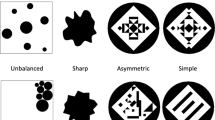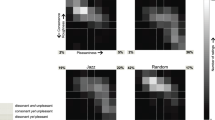Abstract
Forty unfamiliar, one-minute samples of modern jazz were rated by 132 undergraduates for judged complexity, pleasingness and interestingness, in a between-subjects design. Pleasingness and interestingness were positively correlated and both were decreasing linear functions of complexity, although the correlation between interestingness and complexity was low and only marginally significant. It appears that pleasingness acts as a suppressor on the interestingness/complexity correlation: with pleasingness partialled out the correlation was positive and highly significant. Partialling had only small effects on the other correlations. Results suggest that techniques used previously to study non-musical stimuli may also be applicable to music.
Similar content being viewed by others
References
Berlyne, D. E. (1971). Aesthetics and Psychobiology. New York: Appleton-Century Crofts.
Berlyne, D.E. (1974). Studies in the New Experimental Aesthetics. London: Wiley.
Berlyne, D.E. & Ogilvie, J.C. (1974). Dimensions of perception of paintings. In D.E. Berlyne (ed.), Studies in the New Experimental Aesthetics. pp. 181–226. London: Wiley.
Conley, J.K. (1981). Physical correlates of the judged complexity of music by subjects differing in musical background. British Journal of Psychology, 72, 451–464.
Crozier, J.B. (1974). Verbal and exploratory responses to sound sequences varying in uncertainty level. In D.E. Berlyne (ed.), Studies in the New Experimental Aesthetics. pp. 27–90. London: Wiley.
Davies, J.B. (1978). The Psychology of Music. London: Hutchinson.
Day, H.I. (1981). Advances in Intrinsic Motiyation and Aesthetics. London: Plenum.
Hargreaves, D.J. & Colman, A.M. (1981). The dimensions of aesthetic reactions to music. Psychology of Music, 9, 15–20.
Hargreaves, D. J., Messerschmidt, P. & Rubert, C. (1980). Musical preference and evaluation. Psychology of Music, 8, 13–18.
McNemar, Q. (1962). Psychological Statistics. London: Wiley.
Steck, L. & Machotka, P. (1975). Preference for musical complexity: effects of context. Journal of Experimental Psychology: Human Perception and Performance, 104, 170–174.
Vitz, P.C. (1972). Preference for tones as a function of frequency (hertz) and intensity (decibels). Perception and Psychophysics, 11, 84–88.
Walker, E.L. (1981). The quest for the inverted U. In H.I. Day (ed.), Advances in Intrinsic Motivation and Aesthetics. pp. 39–70. London: Plenum.
Author information
Authors and Affiliations
Rights and permissions
About this article
Cite this article
Russell, P.A. Relationships between judgements of the complexity, pleasingness and interestingness of music. Current Psychological Research 2, 195–201 (1982). https://doi.org/10.1007/BF03186760
Accepted:
Published:
Issue Date:
DOI: https://doi.org/10.1007/BF03186760




